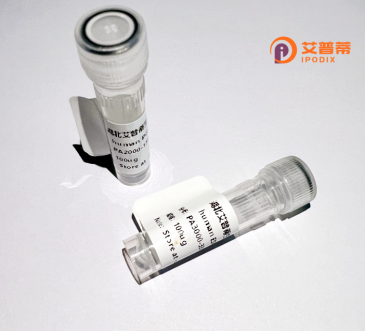
| 纯度 | >90%SDS-PAGE. |
| 种属 | Human |
| 靶点 | CHC1 |
| Uniprot No | P18754 |
| 内毒素 | < 0.01EU/μg |
| 表达宿主 | E.coli |
| 表达区间 | 2-421 |
| 氨基酸序列 | SPKRIAKRR SPPADAIPKS KKVKVSHRSH STEPGLVLTL GQGDVGQLGL GENVMERKKP ALVSIPEDVV QAEAGGMHTV CLSKSGQVYS FGCNDEGALG RDTSVEGSEM VPGKVELQEK VVQVSAGDSH TAALTDDGRV FLWGSFRDNN GVIGLLEPMK KSMVPVQVQL DVPVVKVASG NDHLVMLTAD GDLYTLGCGE QGQLGRVPEL FANRGGRQGL ERLLVPKCVM LKSRGSRGHV RFQDAFCGAY FTFAISHEGH VYGFGLSNYH QLGTPGTESC FIPQNLTSFK NSTKSWVGFS GGQHHTVCMD SEGKAYSLGR AEYGRLGLGE GAEEKSIPTL ISRLPAVSSV ACGASVGYAV TKDGRVFAWG MGTNYQLGTG QDEDAWSPVE MMGKQLENRV VLSVSSGGQH TVLLVKDKEQ S |
| 分子量 | 44.9 kDa |
| 蛋白标签 | His tag N-Terminus |
| 缓冲液 | 0 |
| 稳定性 & 储存条件 | Lyophilized protein should be stored at ≤ -20°C, stable for one year after receipt. Reconstituted protein solution can be stored at 2-8°C for 2-7 days. Aliquots of reconstituted samples are stable at ≤ -20°C for 3 months. |
| 复溶 | Always centrifuge tubes before opening.Do not mix by vortex or pipetting. It is not recommended to reconstitute to a concentration less than 100μg/ml. Dissolve the lyophilized protein in distilled water. Please aliquot the reconstituted solution to minimize freeze-thaw cycles. |
以下是关于重组人Clathrin Heavy Chain 1(CHC1)蛋白的3篇参考文献概览(假设CHC1指Clathrin Heavy Chain 1):
---
1. **文献名称**: "Structure of the clathrin-coated vesicle coat by cryo-electron microscopy"
**作者**: Fotin, A. et al. (2004)
**摘要**: 报道了利用重组人CHC1蛋白与轻链组装成clathrin三腿复合体的结构,通过冷冻电镜解析了其分子构象,揭示了clathrin网格形成的关键分子机制。
2. **文献名称**: "Role of the clathrin terminal domain in regulating coated pit dynamics revealed by small molecule inhibition"
**作者**: Moskowitz, H.S. et al. (2003)
**摘要**: 利用重组人CHC1蛋白研究clathrin羧基末端结构域的功能,发现该区域通过调控网格蛋白的自组装和内吞囊泡的解离影响细胞内吞过程。
3. **文献名称**: "Expression and functional analysis of recombinant clathrin heavy chain for vesicular trafficking studies"
**作者**: Xing, Y. et al. (2016)
**摘要**: 描述了在大肠杆菌中高效表达和纯化重组人CHC1蛋白的方法,并验证其在体外重建内吞囊泡形成中的功能性,为内吞机制研究提供工具蛋白。
---
*注:若CHC1指代其他蛋白,请提供更完整名称以便调整检索结果。*
Recombinant human clathrin heavy chain 1 (CHC1) protein is a key structural component of clathrin, a multifunctional scaffold protein critical for intracellular vesicle formation and membrane trafficking. Clathrin heavy chains (CHCs) form triskelion structures by associating with clathrin light chains (CLCs), driving the assembly of coated vesicles during endocytosis and organelle biogenesis. CHC1. encoded by the CLTC gene, is ubiquitously expressed and plays a central role in clathrin-mediated endocytosis (CME), facilitating receptor internalization, nutrient uptake, and synaptic vesicle recycling. Beyond membrane trafficking, CHC1 participates in cell division, signal transduction, and maintaining cellular homeostasis. Dysregulation of CHC1 is linked to neurological disorders, cancer metastasis, and viral entry mechanisms (e.g., SARS-CoV-2 exploits clathrin for cellular invasion). Recombinant CHC1 proteins, typically produced in bacterial or mammalian expression systems, retain the N-terminal domain responsible for binding adaptor proteins and the C-terminal helical domain essential for trimerization. These purified proteins enable biochemical studies, structural analyses (e.g., cryo-EM), and drug discovery targeting clathrin-dependent pathways. Research using recombinant CHC1 has advanced understanding of vesicular transport machinery and its implications in diseases, offering potential therapeutic avenues for trafficking-related pathologies.
×